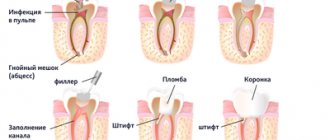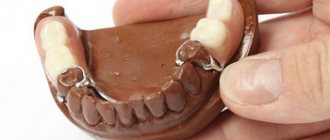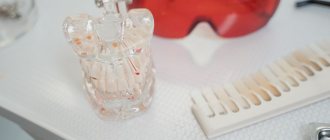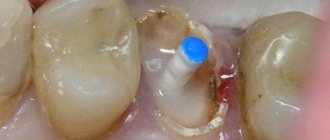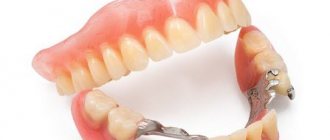In the online store of the LETO trading house you can buy all the necessary tools and materials for simple and high-quality dental restoration. The presented assortment includes several dozen fiberglass pins from trusted manufacturers. They are made in the form of thin rods that have a diameter corresponding to the size of the dental canal. Fiberglass, which forms the basis of the structure, is safe for humans and does not cause allergies. This is largely due to the popularity of these pins in modern dentistry.
Fiberglass dental prosthetics: when and why
Restoring a tooth using a pin
Fiberglass for splinting teeth
Adhesive bridge prosthetics
Many people associate the word “fiberglass” with construction work, but not with dental treatment. At the same time, fiberglass is one of the modern materials actively used in dentistry. With its help you can solve several problems at once. For example, using a fiberglass pin, doctors restore a tooth affected by pulpitis.
Application of fiberglass pins
These structures are used as a support for adhesive prostheses, as well as at the stage of preparation for restoration using crowns and filling materials. Elastic fiberglass pins allow the dentist to preserve the natural roots of even a severely damaged tooth, which is a more convenient and cost-effective restoration solution than complete prosthetics.
When working with fiberglass pins, it is worth considering some of their features.
- Products belong to the category of passively fixed ones.
- For aesthetic prosthetics, it is necessary to select those pins whose shape best matches the characteristics of the root canal.
To restore anterior teeth, cone-shaped structures with a rounded end are used. They allow maximum preservation of hard tissue and minimize the risk of longitudinal fracture. The ratio of the pin diameter to the channel diameter should be 1:4.
Various dual-curing materials can be used to secure the pins in the canal. Due to the polymerization of composites, even in hard-to-reach places, it is possible to achieve reliable strengthening of the entire structure.
Tooth restoration using a pin
Today, fiberglass dental prosthetics is a common procedure that allows you to restore part of a tooth destroyed by caries. The pin is made of thin fibers and is inserted into the dental canal. In essence, it replenishes the functions of the root. From the inside it is filled with composite epoxy resin. This combination gives durability to the denture and completely eliminates tooth corrosion.
Fiberglass prosthetics does not expose the tooth to further destruction, unlike metal pins, since fiberglass has a high degree of flexibility. Besides this, the material has other advantages.
- Lightweight and transparent, so the fiberglass pin is invisible in the coronal part of the tooth.
- Elasticity, allowing you to evenly distribute the chewing load.
- Light transmittance.
- Easy to install.
- Does not lead to root fracture.
If you follow your doctor's recommendations, a tooth on a fiberglass post can last from 5 to 10 years.
Review of composite inlays - purpose in dentistry, pros and cons, alternatives
Article navigation
- What are these structures?
- Materials
- Indications
- Contraindications
- Advantages and disadvantages
- Stages
- Complications
- Life time
- Care
- Alternatives
- Price
Question for a specialist
Dental inlays made of composite synthetic materials are considered an affordable and easy-to-manufacture solution for restoring teeth. But, at the same time, dentists rarely recommend their installation due to the large number of shortcomings of the material. Today we will talk about what a composite tab is, its pros and cons, in what situations it is used, and what alternatives there are.
Fiberglass for splinting teeth
With periodontitis, bone tissue gradually atrophies, exposing the roots of the tooth, which can lead to gradual loosening and tooth loss. To strengthen the dentition, doctors splint teeth using fiberglass thread, which acts as a retainer. Splinting holds loose teeth firmly and prevents them from completely falling out. This makes it possible to gain time and start treating the gums and eliminating the causes of the problem.
Indications for prosthetics
Indications for installation of restorative and stump composite inlays differ. For example, a restoration can be installed if the natural crown is destroyed by no more than 50% (and at the same time more than 2 of its walls are preserved). Restorative ones are usually fixed only on chewing teeth. Stumps are placed in case of more significant damage to the “native” crown - if it is destroyed by more than half, and even if all the walls are broken at the root. But, we repeat, it’s still not worth making composite stumps - they won’t withstand the load.
Rules of care
Oral care after dental restoration involves following the rules of hygiene and the following recommendations:
- after the procedure, you should not eat foods containing dyes, drink coffee, or strong tea for 18-20 hours;
- eliminate high stress on the teeth, use soft brushes, non-aggressive pastes, gels with neutral PH;
- You should not use rinses that contain chlorhexidine - it can change the color of the restoration;
- patients with bruxism need to use special mouth guards to prevent chipping of orthopedic structures;
- adjust your diet: avoid eating nuts, hard vegetables/fruits, colored carbonated drinks, beets, quit smoking and alcohol, too cold/hot food, which can cause chips and cracks in the material and loss of its snow-white color.
If external changes, increased sensitivity and pain occur, you should immediately contact your dentist to eliminate serious complications. For the purpose of prevention, it is necessary to visit a doctor twice a year.
Microprosthetics with inlays
Modern dentistry, instead of conventional tooth filling, offers the option of restoring teeth using microprosthetics with inlays. This method allows you to restore and preserve a large part of the tooth.
Inlays for microprosthetics are made from various materials - ceramics, zirconium, gold or cobalt-chrome.
It is worth noting that the inlays last an order of magnitude longer than conventional fillings due to their denser structure than that of filling materials and the tightest fit of the inlays to the tooth tissue. The latter quality allows you to avoid the risk of recurrent caries and inflammatory processes.
During microprosthetics, a ready-made inlay (microinsert) is installed in the cavity of a living tooth, which will ensure the restoration of the coronal part, even if no more than a third of it remains.
Indications and contraindications
Indications
:
The goals of the procedure are to restore the color, shape, and functionality of the tooth. Restoration eliminates crown chips, cracks and irregularities, fragments of destroyed tissue, damage/thinning of enamel, manifestations of a wedge-shaped defect, caries:
- correction of aesthetic indicators;
- treatment of lesions and inflammations of non-carious/carious origin with complete regeneration of the organ’s performance indicators: production of an artificial unit/bridge in the laboratory, filling of carious cavities.
Contraindications
:
The intervention is not performed if you have a pacemaker, are allergic to restoration materials, or are unable to fully isolate the tooth or oral cavity from moisture. If a patient is diagnosed with severe symptoms of bruxism, pathological bite, or increased abrasion, a preliminary consultation with a neurologist, psychologist, or dental therapist is required.
How is the effect achieved?
Looking at the photo of splinting teeth with fiberglass, you can see that the group involved in the splint is one whole and absolutely motionless... and this effect is not deceptive. The fact is that when illuminated, the fiberglass tape becomes very hard, and its fixation on the teeth makes it possible to redistribute the chewing load between the teeth. Even if the patient bites on one tooth, the load will be distributed over all teeth that are involved in the splint. This approach eliminates the loss of contact between teeth, which is observed with periodontitis. With it, each tooth receives maximum load, which leads to even faster progression of the disease. Thanks to the use of fiberglass tape, the process of bone atrophy slows down and often stops completely.
Fiberglass splinting technique
Fiberglass threads have been used in dentistry relatively recently. The prices for splinting teeth with fiberglass are affordable, and the effect of the procedure has earned high marks from both doctors and their patients.
The procedure is carried out in several stages by an experienced specialist and includes the following:
- In order to prepare teeth for installation of a splint, they are cleaned of deposits, abrasive surface treatment is carried out, during which a horizontal recess is created for laying fiberglass tape, and the surface of the teeth is etched;
- Laying the tape into the recess is carried out gradually, inserting it into the spaces between the teeth;
- A light composite is applied and polymerized;
- The surface is sanded.
Teeth extension
If 20 years ago dentists solved such problems as deep caries, injuries, chips or age-related wear of teeth using a radical method, installing a rough filling, removing the remaining stump or installing expensive dentures, today, thanks to the extension of the frontal/masticatory units, you can easily get your tooth back , even if only its root or stump remains.
When building teeth, the material is selected in such a way that it completely imitates the anatomical features of bone tissue and matches it both in strength, texture and shade.
Before | After |
Over time, modern materials for building crowns do not lose their appearance; only a specialist can distinguish a natural tooth from an extended one. In untreated cases, teeth extension occurs in one session. The service life of the product is about 10 years.
This method cannot be used if, for various reasons, it is not possible to protect the place of work from contact with saliva. Under such conditions, the filling on the front or back teeth will not harden.
Contraindications for installation
Contraindications include childhood, pregnancy, and the presence of cracks in the roots and inflammation underneath them. As for contraindications specifically for the varieties, it is not recommended to fix a composite restorative inlay on the front teeth and in case of large damage to the chewing crowns - the exception is dense composites for milling. Composite stumps are not installed on chewing teeth, because the latter experience the highest loads during grinding of food.
“The dentist did not advise me to make a composite inlay at all. He said she wouldn't last long. And in a few years you will have to get prosthetics again. Therefore, I decided to immediately make a good ceramic one, they say that they can last a very long time. Unless, of course, you chew nut shells with them.” Svetlana Alekseevna, review from forum.stom.ru




